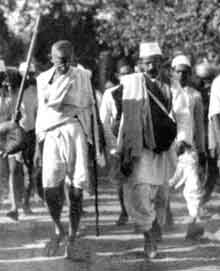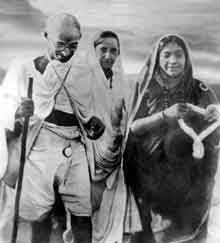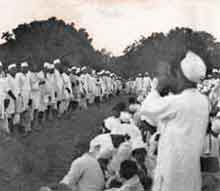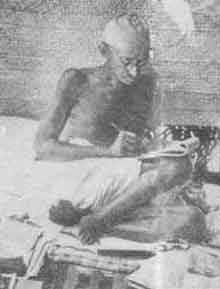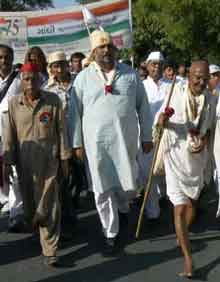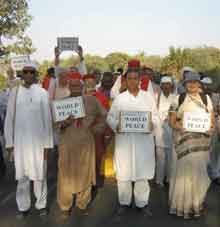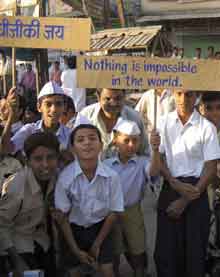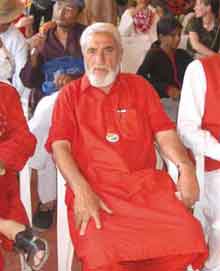The climactic phase of India’s independence struggle began on March 12th, 1930 when Mahatma Gandhi marched out of his beloved spiritual community, the Sabramati Ashram, vowing never to return until India was free from the British colonial system. He was accompanied by 78 hand-picked colleagues who had developed a deep devotion to the pursuit of Truth and nonviolence, and lived on a daily basis the principles of egalitarianism, co-operation, equitable distribution of resources, respect for all faiths, and simplicity.
Their mission: to obtain salt from the beach at Dandi, 241 miles away.
An Experiment in Truth
Britain was the mightiest empire the world had ever known, and India its “crown jewel.” Gandhi was leading a vast “experiment in Truth”: he was using the power of his heart to usher the oppressive British regime out of India as friends, not enemies. Gandhi and his fellow seekers implemented two primary methods to accomplish this seemingly impossible task.
The first, constructive programme, consisted of indigenous, local, self-reliant projects such as cotton spinning, education, Hindu-Muslim reconciliation and unity, and adoption of a national language. Gandhi believed that by relying on themselves, Indians would rebuild their civilization, and by doing so, liberate themsleves from their dependence on British services, commodities, and structures.
Gandhi’s second method, obstructive programme, complimented the first and was designed to firmly, clearly, and respectfully communicate to the British that their rule was unwelcome. Non-cooperation included general strikes and boycott of foreign cloth. Civil disobedience was enacted by intentionally and openly defying morally repugnant laws.
Holding Fast to Truth
By the time he had reached the beach at Dandi over one month later, thousands had joined the march. Gandhi meant to challenge the unjust British monopoly on salt production, which made it illegal for any Indian to prepare their own salt. In a tropical climate, salt is a necessity of life. Gandhi believed that his movement implemented a firm stance to right a wrong using right means. He coined the word “Satyagraha” (literally, “holding fast to Truth”) to reflect this philosophy of righteous nonviolent struggle.
When Gandhi bent down to pick up a pinch of salt, the Salt Satyagraha was launched, and civil disobedience began as Indians nationwide produced and sold salt. The Salt Satyagraha movement was both obstructive, in that it opposed a structure of violence imposed by the British, and constructive, in that it encouraged Indians to self-reliantly produce their own salt.
As part of the obstructive programme, Gandhi believed that there comes a time in a nonviolent movement when one must be willing to accept self-suffering to reach the hearts of the oppressors when their minds are closed to reason. Gandhi was meticulous in his attempts to respectfully dialogue with the British regime about his concerns, and only began a Satyagraha movement when he was convinced there was no other way to reach the British on a deeper level.
Thousands were arrested, including Gandhi himself, and the jails packed. On May 21, 1930, over 2,500 Indians “raided” the Dharasana salt works, a salt production facility controlled by the British regime. Column after column of Indians advanced toward the gates and were severely beaten by the native police under British direction. Not one of the Satyagrahis raised a hand to defend himself as the clubs rained down, fracturing skulls. Many lost consciousness, and several perished. In the Gandhi movie, the scene was famously encapsulated by a Western reporter: “Whatever moral ascendancy the West once held was lost here today.” The Indians accepted this suffering on behalf of the Truth they clung to of ending colonial rule.
While the Salt Satyagraha did not “succeed” in its short-term, situational objective – the salt laws were not repealed – it worked on a deeper level. British public opinion was deeply affected by the Dharasana nonviolent moment, which shockingly revealed the violence inherent in the British colonial system. Ultimately, this led to India’s independence in 1947.
Salt March 2005
On March 12th, 2005, Tushar Gandhi set off to retrace his great grandfather’s footsteps, accompanied by 78 companions. I was only able to participate for the final six days. By the time I joined, the crowd had swelled to many hundreds. A fascinating hodgepodge of seekers had converged on this small stretch of Gujarat, India. We marched for unique personal reasons, yet many of us were united by a common vision: to more deeply understand and connect to Gandhi’s legacy.
In addition to the hundreds of Indians, there was a contingent of Pakistanis, many from Badshah Khan’s Northwest Frontier Province. A colleague of Gandhi’s, Khan organized the world’s first nonviolent army, comprised of 80,000 Muslims who successfully opposed the British (see page 18). Also, there were internationals from 11 countries, including Ireland, China, and New Zealand.
While some of us walked for spiritual reasons, others seemed drawn to the political aspect. The Congress Party co-sponsored the event and organized a massive rally of (reportedly) 300,000 people to see Prime Minister Singh and Sonia Gandhi (unrelated to the Mahatma). Their orange and green flags often blanketed the horizon.
In the end, more than a few of us experienced the 75th anniversary march as a renewal of faith. Contemplating the countless movements that have incorporated the teachings and example of Gandhi, such as the US civil rights movement and the Philippines People Power movement that led to the ouster of dictator Ferdinand Marcos in 1986, I believe we have just begun to realize the power of active love to transform conflict and catalyze positive social change. On the salt march, we took small steps toward a beach, and on behalf of a new direction for humanity.

